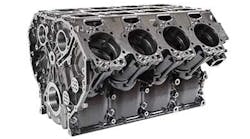Synchronous error plots mirror the machined-part geometry, as indicated by comparing the roundness plot of a hole and the error motion plot of the spindle that cuts it.
Asynchronous error plots how how the tool point will cut on successive spindle revolutions. In this case, the tool will cut with an average 7.65 m peak-to-valley motion.
Spindles get blamed for a lot of machining problems but, in many cases, the spindle is not the root cause of the problem. Crashes and heavy cuts can eventually lead to a need for a rebuild, and, when quality problems crop up, a tool is needed that can identify quickly whether it is time to change-out the spindle, or if the cause of the problem is a process elsewhere in the machine system or beyond.
The diagnostic tool that determines if a spindle is the cause of machining problems is the measurement and analysis of spindle error motions. Combined, careful measurement and an analysis of the spindle will tell if the spindle is at fault or if something else is causing unwanted spindle motion.
Spindle error-motion testing is especially important for shops that want high accuracy and shops that machine expensive parts for which machining errors that lead to scrap are costly. Also, shops that purchase new machine tools can determine the machine's capabilities through spindle-error testing as an aid for scheduling jobs on the new machine based on the precision that is required for the job.
Shops use spindle error-motion testing to measure the characteristics of a spindle as it is mounted in an operating machine. A test in an operating machine measures the effects of other possible error sources, in addition to the spindle itself. "For example, in one shop a surface finish problem developed and testing indicated the spindle was running true. The problem was in the workpiece fixturing that was bending under cutting loads," said Don Martin, director of development at Lion Precision ( www.lionprecision.com).Government research laboratories were among the earliest to benefit from spindle metrology and spindle error-motion tests. Those research laboratories were shrouded in secrecy, and restricted from divulging information about their projects, yet they needed to buy and use machine tools. They also could not test the accuracy of the machine tools they purchased by making test parts, so they took another route: They determined the spindlemotion specifications that they needed, then test procedures and software were developed to ensure appropriate spindle performance. Spindle-motion testing is a more exacting and more comprehensive way to analyze machine tools for possible errors than machining test parts. Excessive errors when machining test parts produce only scrap, and some errors may become apparent only when future jobs are run. Spindleerror testing also allows spindle manufacturers to determine the characteristics of new spindles they produce.
Thermal Troubles
Thermal growth is the largest single source of machining problems such as feature-location or hole-depth errors. Spindle drives are a large heat source that transfer heat to other, cooler parts of the machine, and the heat transfer causes transient thermal variations — uneven heating of parts of the machine tool — that results in bending and distortions in the machine tool's structure. The heat induced distortions cause the spindle to distort, and misaligns the cutting tool. Such distortions can be particularly problematic in gantry-type machines because of the distance from the gantry structure to the tooling. Distortion in a machine tool's gantry is magnified at the tool point.
While thermal distortion problems can occur in all types of machine tools, those that are designed symmetrically or designed to minimize heat loads and those that have spindlecooling jackets are less susceptible.
Thermal distortions can arise in machine elements that are not related to the spindle, and they also can cause errors. Martin cites an example in which a shop had difficulty holding the tolerance on a feature-location for a part. The problem originally was thought to be a spindle problem, but a careful analysis showed the cause was thermal cycling in a ballscrew that was equipped with internal fluid cooling. The internal coolant caused the ballscrew to expand and contract, moving the workpiece in a way that suggested the spindle position was off. Tightening the coolant temperaturecontroller deadband from an original 20F to a fraction of a degree solved the problem.
Measuring The Motions
| What's new in precision bearings and spindles? Spindle metrology researchers
|
Error Motions
This plot shows the effect of speed change on axes' shift. The heavy lines are acceleration to about 4,000 rpm and the lighter lines show the effects of deceleration to 100 rpm. The spindle did not return to its starting positions, and the Z axis (red plot) was farthest away from its starting position.
In the world of spindle metrology, six different motions are possible. Pure rotation around the spindle axis (Z axis) is the desired motion. Motion in any of the other five directions (X, Y, Z, tilt along the X axis and tilt along the Y axis) are considered errors. Tilt measurements allow the error to be calculated at some distance projected beyond the point at which another measurement is taken. This is useful for projecting the potential error in a boring bar that may be too long to measure at the actual tool point.
Spindle errors are classified to distinguish the root cause of the error or its effect on part quality.
Drift is a slow change that occurs over time as a result of some external influence, such as temperature, that makes a change in the position of the tool.
Shift is an abrupt change in an operating parameter as a result of some change in the system, such as a speed change or an air-pressure change on an air-bearing spindle. Because high-speed machining involves a considerable level of centrifugal force on spindle components, speed changes can cause bearing elements that affect tool position to be repositioned.
Synchronous error motions repeat every revolution of the spindle. A plot of these errors shows lobes that can occur once, twice or at some multiple of times per revolution. Synchronous error motion, which also is known as out-ofroundness motion, predicts the ability to bore a round hole or to turn a round part. The tool will cut a part with the same number of lobes as shown in the synchronous error motion plot.
Shops can measure the synchronous error motions of spindles to determine which spindles they should use for critical jobs. Also, this testing is useful to determine the effects of a crash on a spindle's precision.
Spindles typically run true until they operate at a resonant speed that results in excessive vibration. Synchronouserror motion plots, diagrammed at various spindle speeds, can make resonant speeds apparent to allow operators to avoid them.
Asynchronous error motions are not synchronized with spindle rotation and do not repeat on successive spindle rotations. These error motions are characterized by the "fuzziness" of a polar plot, and are related to surface finish. Asynchronous error motions can develop as a result of the interaction of spindle-bearing elements that are rotating at different speeds,such as rolling elements, rolling element retainers or cages, and bearing races. Asynchronous errors also can develop from a machine tool's non-structural elements such as hydraulic pumps or coolant pumps, and they can develop from such external factors as a forklift driving past the machine. Martin said he is aware of an asynchronous error that was caused by the machine operator's radio: The operator had the volume turned too high, and the part required precision surface finish.





